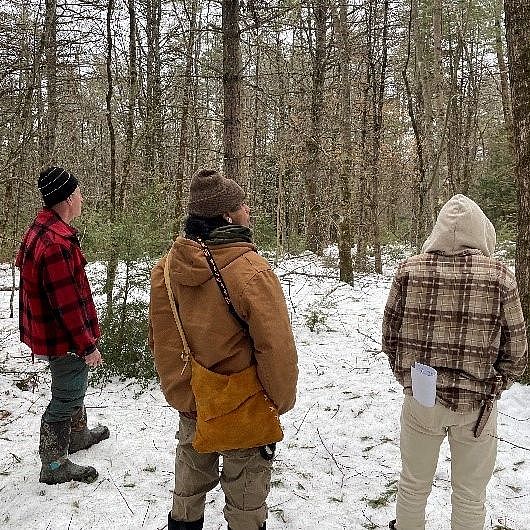Indigenous Co-Management in Action

Written by Jenn Albertine in collaboration with Andre Strongbearheart Gaines Jr and Tessa Dowling
In 2022 Mount Grace began to incorporate Indigenous traditional ecological knowledge (TEK) into how we think about and actively manage the lands that we steward. We entered this work in partnership with the Indigenous non-profit No Loose Braids, led by Nipmuc citizen Andre StrongBearHeart Gaines, Jr. Two current management projects that that are benefiting from the collaborative vision of our professional forester and Nipmuc cultural stewards are Song Memorial Forest in Warwick and Guiney Memorial Forest in Royalston. Both projects are centered on creating healthy ecosystems that support biodiversity, wildlife habitat, and the cultural needs of our Nipmuc partners.
Our consulting forester, Mike Mauri, has spent hours in the woods with cultural stewards from No Loose Braids reviewing the forest cutting plans ensuring that our goal to create a healthy ecosystem is in line with our Indigenous partners’ traditional ecological knowledge and cultural needs.
Our work at Guiney is supported by funding from the Cornell Lab of Ornithology and USDA/USFS Landscape Scale Restoration Grant in collaboration with the Ruffed Grouse Society. These grants will provide enough funding to help us to break even while paying a living wage to the people carrying out the work of creating a healthy ecosystem.
The project will focus on 12 acres of the 32.9-acre parcel. Most of this area is abandoned agricultural fields that are dominated by a dense canopy of unhealthy white pine trees, shading out the understory plants. Opening the canopy will encourage dormant understory seeds to germinate, increasing plant biodiversity. Wildlife species who need a diverse understory will benefit from food and habitat provided by this new growth. The “disturbance” of sections of forest like this is an essential element of larger forested landscape’s health & resilience to stressors like invasive species, diseases, and a changing climate.
Another tool for forest management that takes site specifics into account is tree girdling. This involves selectively killing some red maples in the spruce-fir-tamarack swamp to improve the health of those key species which are uncommon in our service area. By girdling rather than logging we keep heavy equipment out of a more sensitive area and create bird habitat in the standing dead trees.
Our Indigenous partners plan to help steward the regeneration of the forest after the timber harvest by planting species of cultural importance, much like their ancestors have done for 10,000+ years. The more diverse landscape created through this forest management allows them to utilize the property for gathering culturally important food and medicine.
At Song Memorial Forest, we have a forest management project focusing on 50 acres of the 84-acre parcel. What is exciting about this project is that we are installing a 7-acre slash wall to limit deer and moose browsing, which will help the forest regenerate faster and with more diverse tree species.
Hungry deer and moose tend to specifically over-browse white oak seedlings, a culturally important food source for our Indigenous partners. Slash walls are an effective way to exclude moose and deer that don’t require bringing in any outside materials, creates habitat for small animals in the walls, and break down over time as the tree saplings grow big enough to be resistant to browsing.
Monitoring plots will be set up inside and outside of the slash wall to measure its impact on the forest regeneration. We will also be collecting data on the property from regular in-person visits, in collaboration with our Indigenous partners, and will be using satellite imagery from remote monitoring technology.
This slash wall project was funded by a grant from Hollis Declan Leverett. The project will provide us with a small amount of timber income, which will be used to fund continued collaboration with our Indigenous partners in the co-management of Mount Grace lands and support them in renewing their ancestral cultural practices.
Stay tuned for tours of both properties later in 2024.
